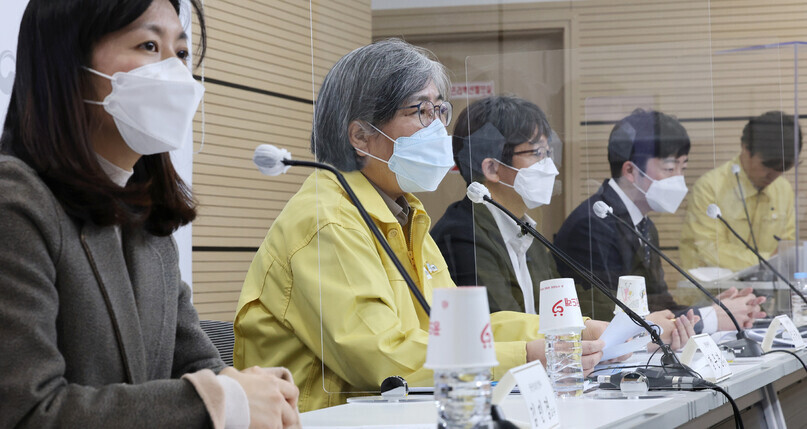hankyoreh
Links to other country sites 다른 나라 사이트 링크
Omicron’s reinfection rate 16 times that of Delta variant, says KDCA

With COVID-19 cases soaring since Omicron became the dominant strain in South Korea, experts say that Omicron’s reinfection rate is over 10 times greater than Delta’s. According to experts, the main symptoms for Omicron are not a high fever, but a runny nose, headache and low energy.
The Korea Disease Control and Prevention Agency (KDCA) brought infectious disease experts to a regular COVID-19 briefing on Thursday afternoon to answer the public’s questions about the variant. Experts said that while Omicron causes milder and briefer symptoms than Delta, the new variant poses a high risk of reinfection.
“There’s a strong likelihood of immune escape,” said Kim Min-kyung, one of the experts at the briefing. Kim, who is a professor of infectious disease and internal medicine at the National Medical Center, explained that people who have already been infected with another strain of COVID-19 could still catch the Omicron variant.
“Looking at overseas examples, [Omicron] presents a higher chance of reinfection. Omicron has such a high mutation [rate] that the immune system doesn’t remember it and regards it as a new virus,” she said.
Kim added that according to UK figures, the reinfection rate was 16 times higher during the Omicron wave than during the Delta wave.
Since Omicron is more than twice as infectious as Delta with a higher reinfection rate, experts predict that Korea’s caseload would rise sharply for much of the next two months.
“The number of cases could increase for the next five to eight weeks, and the rate of increase might remain very high. The number of cases this week nearly doubled from last week, and I think that rate will continue,” said Jung Jae-hun, a professor of preventive medicine at Gachon University College of Medicine.
“While the number of critically ill patients will increase at a slower rate than with Delta, I think that the peak of this wave will test the limits of the preparations we’ve made to handle severe cases,” Jung said.
The most common symptoms by Omicron can be identified are “a runny nose, headaches, low energy, sneezing and a sore throat,” Kim said.
“The main symptoms of the Omicron variant aren’t very different from Delta, but symptoms are milder and shorter, and fevers break quickly,” she explained.
Along with milder symptoms, Omicron cases are less likely to become severe or critical or end in death. “In terms of severity, Omicron certainly seems to be less severe than the Delta variant,” Kim explained.
Kim said that data from the UK and South Africa, which faced Omicron waves before Korea, shows that Omicron’s hospitalization rate is between one-third and one-fifth that of Delta. Data about the Korean case fatality rate recently released by the KDCA shows that Omicron is at one-fifth the level of Delta, she added.
“Around 75 Omicron patients were admitted to the National Medical Center between early December and Jan. 20. For most of those patients, symptoms were mild, their chance of developing a high fever was low, and their fever didn’t last very long,” Kim said.
Not one of those patients needed oxygen therapy for pneumonia.
When asked how Omicron compared to the seasonal flu, Kim said, “We believe that it’s a little more infectious and a little more severe.”
Omicron doesn’t seem to present a particularly large risk for infants or young children.
“There are also reports overseas about a big jump in the hospitalization rate for infants and young children, but that doesn’t mean they’re more likely to catch the disease or are in any particular danger. Since infants and young children aren’t eligible for the vaccine, this could be impacting the surge of patients,” Kim said.
By Jang Hyeon-eun, staff reporter
Please direct questions or comments to [english@hani.co.kr]

Editorial・opinion
![[Column] Welcome to the president’s pity party [Column] Welcome to the president’s pity party](https://flexible.img.hani.co.kr/flexible/normal/500/300/imgdb/original/2024/0515/3917157400447943.jpg) [Column] Welcome to the president’s pity party
[Column] Welcome to the president’s pity party![[Editorial] Korea must respond firmly to Japan’s attempt to usurp Line [Editorial] Korea must respond firmly to Japan’s attempt to usurp Line](https://flexible.img.hani.co.kr/flexible/normal/500/300/imgdb/original/2024/0514/2317156736305813.jpg) [Editorial] Korea must respond firmly to Japan’s attempt to usurp Line
[Editorial] Korea must respond firmly to Japan’s attempt to usurp Line- [Editorial] Transfers of prosecutors investigating Korea’s first lady send chilling message
- [Column] Will Seoul’s ties with Moscow really recover on their own?
- [Column] Samsung’s ‘lost decade’ and Lee Jae-yong’s mismatched chopsticks
- [Correspondent’s column] The real reason the US is worried about Chinese ‘overcapacity’
- [Editorial] Yoon’s gesture at communication only highlights his reluctance to change
- [Editorial] Perilous stakes of Trump’s rhetoric around US troop pullout from Korea
- [Guest essay] Preventing Korean Peninsula from becoming front line of new cold war
- [Column] The state is back — but is it in business?
Most viewed articles
- 1[Column] Welcome to the president’s pity party
- 2Could Korea’s Naver lose control of Line to Japan?
- 3[Editorial] Transfers of prosecutors investigating Korea’s first lady send chilling message
- 4US has always pulled troops from Korea unilaterally — is Yoon prepared for it to happen again?
- 5Major personnel shuffle reassigns prosecutors leading investigations into Korea’s first lady
- 6Naver’s union calls for action from government over possible Japanese buyout of Line
- 7[Editorial] Korea must respond firmly to Japan’s attempt to usurp Line
- 8[Column] Will Seoul’s ties with Moscow really recover on their own?
- 9S. Korean first lady likely to face questioning by prosecutors over Dior handbag scandal
- 10In Yoon’s Korea, a government ‘of, by and for prosecutors,’ says civic group